The Gap [1843-1949]
Primary tabs
Submitted by Admin on Mon, 2010-08-30 17:44
Current condition:
Demolished / No longer exists
Date Place completed:
c.1843-05-01 (Month, Day are approximate)
Date Place demolished:
c.1949-12-31 (Month, Day are approximate)
Today it's part of Queen's Road East, but originally Queen's Road only ran east to around the junction with Kennedy Road. The last short section of road over and down to the juction with Morrison Hill Road was called The Gap, or later Gap Road.
Here's a photo of the gap. When Morrison Hill was still a hill, the road ran through a cutting, or 'gap'.
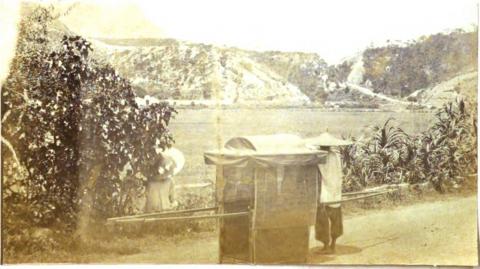
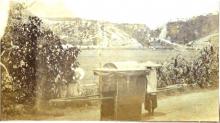
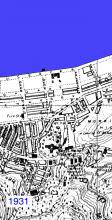
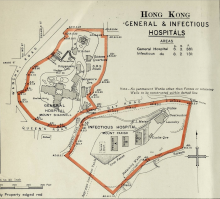

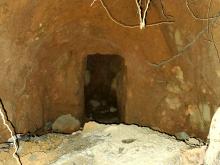
Comments
Any idea when it was
Any idea when it was incorporated into Queen's Rd East?
I'm guessing it was when they
I'm guessing it was when they threw Morrison Hill into the Harbour for the Wanchai reclamation. http://gwulo.com/node/7795
The disappearing Gap
I searched for 'Gap Road' at HKGRO, and found this entry for 1934:
GA 1934 (suppl) no.142. Tenders invited for the erection of an Advertisement Hoarding at junction of Gap Road and Morrison Hill Road
So it was still in use then. But a map dated 1958 (Plate 7-3, 'Mapping Hong Kong) shows it as "Queen's Rd E".
Changes to road names would be announced in the Gazette, so that would be a good place to look for a firm date.
Regards, David
THREE PICTURES IN WONG-NE|
THREE PICTURES IN WONG-NE|-CHUNG, #E9
HERE is a lovely spot in Hongkong, a little plain, whereon the Race <! :) Course is built, surrounded by hills that have been the burial grounds (# the Hongkong people for many a long year, which is as full of \'ryocharms, glimpses of rich scenery, shady woodland, pleasant meadow, &: £ brooks, streams and waterfalls as any spot of the same Lé size which it has ever been my lot to see. Like the Ladye fayre of olden time who prayed her departing lover to “Look upon her mirror And leave his image there,” I often longed for something to remind me of Wong-nei-chung when I should be far away, something that would arouse in me the same feeling of delight, and gratify my sense of beauty as it was gratified when I looked upon that pleasant vale itself. I thought I should like to have it photographed, but to photograph all its beauties would require that at least a hundred plates should be taken; nevertheless, I was glad enough to have an opportunity of obtaining only a small percentage of that number, and went in high glee with a photographer to take three pictures in Wong-nei-chung. “You want three views of the valley,” said he, “but you needn't have three unless you like. I've got a wide angle lens that'll take it all at once. Look here!” He had fixed his camera on Morrison hill which is, as you know, at the mouth of the valley, and I looked into it to see his picture. There was the valley—the whole of it—all that I could see in nature by looking first before me, then below me, then on the right side, and then on the left, was presented at a glance upon the camera screen. In the foreground was a black mass that was incomprehensible to me, but then came the bridge and the smooth vale, there were the cemeteries with trees waving their mournful plumes over the graves, above them the great hills rose, in the middle was the Stanley road winding up among the trees into the hills—everything was there, but— [graphic] There was a ghastly distinctness about it all; the hills that I knew to be in the distance were as clear as those close at hand, and looked as they would appear through a telescope, not soothed into that wondrous gentleness of colour and delicate detail which is the sweetest charm of distant hills, while that great eminence close at hand which is so much grander in its proportions than all the rest, and on whose abrupt forehead a magnificent invincible peace is enthroned, had become an insignificant item in a scene that was an elaborate piece of intricate detail, suggesting no ideas, arousing no pleasant sensations, touching no sense of the beautiful—it was a wonderfully exact CHART of the valley, but not a picture. “What is that in the foreground !" I asked. “That's the tops of trees,” said Photographer, and I thought “you will have to write ‘tops of trees on the photograph, or no one will know what they are. “Just look at the angle that's taken in,” he continued, “You can see the whole valley at once, and ” (with a look of transcendent triumph) “you can count every post in the Race Course railing.” I confess that I felt humiliated. I believed myself to be a lover of nature —an admirer of good scenery, and had spent many and many a pleasant hour in Wong-nei-chung under the impression that I was appreciating the charms of hill and dale, woodland and glen; yet all my admiration, all my enthusiasm, all my appreciation had never aroused me to such a sublime pitch of ecstasy as would have caused me to count the posts in the Race Course railing ! When Niepce, the inventor of photography, sent to his brother his first triumph, he selected, as the one feature of the picture to which he would direct especial attention, the representation of a patch or mark upon a pigeon house which was an item in the scene he had photographed. From that day to this, fascinated by the absolute accuracy with which the sun paints his pictures, photographers have sought to produce distinct but lifeless charts of the mechanical proportions of nature, leaving out altogether the feeling, the ideality, the soul with which all nature is flooded; they care nothing for the grandeur of a lofty hill, for the peaceful light that sleeps upon its forehead, for the solemn chastened gloom that slumbers at its base; they do not value one atom the softened sweetness of those other hills waning in the distance, they cannot see the contrast which the dark sharp distinctness of the adjacent tree makes with the far off woods, so cloudily so mysteriously beautiful, all these things and all such things can be dispensed with if only a presentment be produced whereon you may count the posts in the Race Course railing ! There are some subjects, it is true, which must be photographed in this chart-like manner, or not at all; but, except under very adverse circumstances, it is nearly always possible to so arrange a photograph as to infuse into it something of the life of nature. This has been found out and acted upon with regard to portraits, and it is but seldom we see the flat, flabby, featureless charts of corpse-like faces that were so often met with ten years ago. It is also often practicable to take a picture which shall be consistent with the rules of art— shall be in fact a composition in which the nature of the scene shall be not only represented, but represented to the best advantage. Let us hear very briefly what Mr. Ruskin says of composition, and try how far we can carry out his principles in taking our three pictures in Wong-nei-chung. “Composition means literally and simply, putting several things together, “so as to make one thing out of them; the nature and goodness of which they “all have a share in producing. In a great picture, every line and colour is so “arranged as to advantage the rest. “The great object of composition being always to secure unity, that is, “to make out of many things one whole; the first mode in which this can be “effected is by determining that one feature shall be more important than all “the rest, and that the others shall group with it in subordinate positions. But “the observance of the rule is often so cunningly concealed by the great com“posers, that its force is hardly at first traceable; and you will generally find “they are vulgar pictures in which the law is strikingly manifest.” I have arranged a picture in the camera and, as far as I am able, I have arranged it in accordance with these principles. Do not misunderstand me! My share in the composition is very very small indeed; I have only permitted nature to do what she is always willing to do, if photographers do not stand in her way. There is the picture. I call it ‘Wong-nei-chung Village. See if you can discover its principal subject! Is it the village? Examine it and see if everything else is subordinate to the village. Scarcely so, I think; the trees on the right hand of the foreground contrast richly in their depth of colour and distinctness with the softer outlines of the distant houses, and help you to see how far they are from where you stand, but the remainder of the foreground bears little or no relation to them. The village then is subordinate to something else. Is that something else the hill in the back ground ! Look carefully, again and again, and by degrees you will come to see that everything in the picture, from first to last, unites to convey to you an idea of the grandeur and the grace of that great hill. Its outline is echoed in that of the trees in the right foreground. There is the same sudden rise at the summit, and the same slope below, which, in the trees, breaks off soon and droops to the earth, while in the hill it flows grandly away into the far distance. These trees are themselves echoed by the bush on the other side, the outline of the main portion of which, begins a graceful curve which is continued by the hedge on the opposite side of the road, and over the nearer pines, and goes out of the picture in the patch of grass by the roadside. Then there is the village; look how it nestles | The trees in front hold themselves just high enough to let you peep at it but no more, and you see it surrounded by clouds of other trees that clothe the hill. Do you note how all this gives to the hill the air of a protector? and see how nobly it bears its character! Rising above all, nobler than all, greater than all, calmer than all, it looks royally down upon the landscape of which it is the King, and in token of its kingship wears a crown of golden light upon its forehead, placed there by the morning sun. This is what your camera can do for you. Why not let it do so oftener? But we have to take two more pictures, and the next shall be a simpler one. Two or three figures are loitering in a road on which the sun shines brightly. A tall black tree in the left foreground, with a dense undergrowth of bushes, throws a shadow across the path to the other side where stands another tree that is brighter in colour because it is lighted by the sun. A bank of rolling trees stretches away into the middle distance, beyond, a hill reclines, and further still, another hill—all basking in the sun. This is a picture of lazy peace. The third picture is to be one of a different kind. It is to be a photograph of a piece of engineering. In making a convenient road to the valley from Victoria, it was necessary to make a deep cutting, and we want a photograph of this cutting; let us see if we can make it a little picturesque. And, apropos of that same cutting—the Wong-nei-chung Gap—perhaps you do not know that, according to the best Chinese authorities, it was a dreadful day for Hongkong when that Gap was made. The Chinese, ever imaginative in their superstitions, profess to see in every hill, or range of hills, the shape and conformation of a dragon. When the dragon's form is not sufficiently clear, or if it be defective or wanting in any part, they will raise a mound, or build a pagoda, or in some other way supply the missing feature. Now in the present case it unfortunately happens that Morrison Hill was the dragon's nose, and when the Gap was made the dragon's nose was cut off from his face. This has made the dragon irate and he intends, we are informed, to hurl dire misfortunes upon Hongkong one of these fine days. We can see the Gap from where we are in Wong-nei-chung road, and I think that we shall be able to make a passable picture of it which, if not a very brilliant example of art, shall not be too rigidly formal. We want something in the foreground which shall be interesting but not striking, and which shall break without hiding the monotonous sweep of the plain. A chair and coolies is the most natural thing in the world, but the group must be inactive, the chair upon the ground and the coolies doing nothing particular, otherwise they will be too prominent in the picture. These, with a bush on the one hand, and a bit of pine on the other, remove all tensive sameness and at the same time educate the eye to appreciate the broad plain beyond, and follow the road up through the Gap, the height and breadth of which you are enabled to grasp at once by comparing it with everything else in the picture, while Victoria Peak lifting its head into the lowering clouds is softened into dimness by the distance and so made subordinate to the whole. I say then that it is not necessary that every photograph should be a
The Gap was finished in 1843
The China Review, Or, Notes and Queries on the Far East, Volume 18
The Gap was finished in 1843
Wang Antung and Hienling, visited Hongbong (11 May, 1843) were freely introduced to Hongkoog society, dined twice with Sir H. Pottinger, drove out in a carriage (the first that passed the gap) to the Happy Valley, spent an evening at the Morrison Education Society's Institution (on Morrison Hill),
https://books.google.com/books?id=8rZAAQAAMAAJ&lpg=PA318&ots=xE3OvHUFmd&...
1949
I think I have found the year of when "Gap Road" was incorporated into Queen's Road East - 1949
"Government plans to change the name of Gap Road to Queen's Road, East.
Any objections to this alteration should be addressed to the Director of Public Works, Lower Albert Road within one month"
Source: The China Mail, page 3, 29th December 1948 and also see the "Notice" in The China Mail, page 4, 29th December 1948